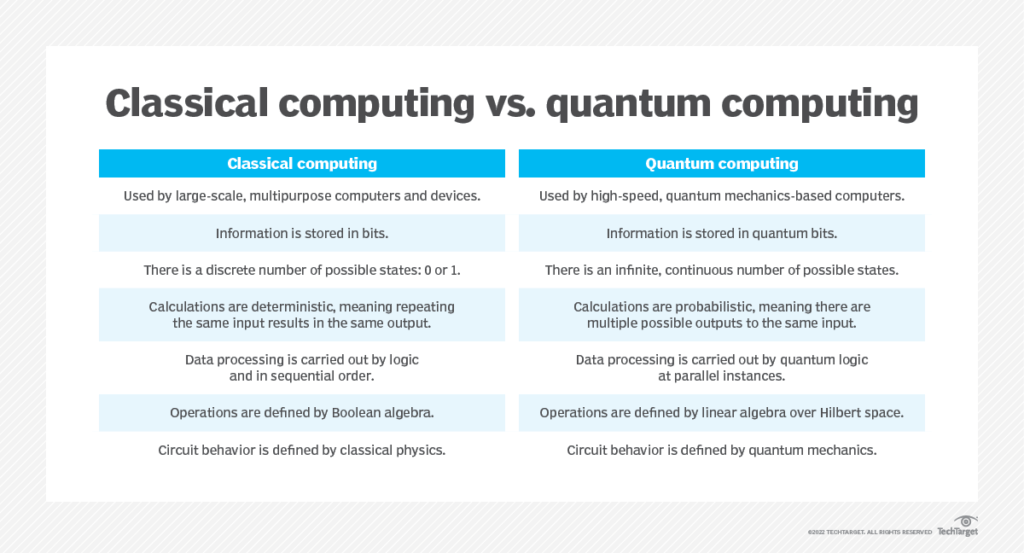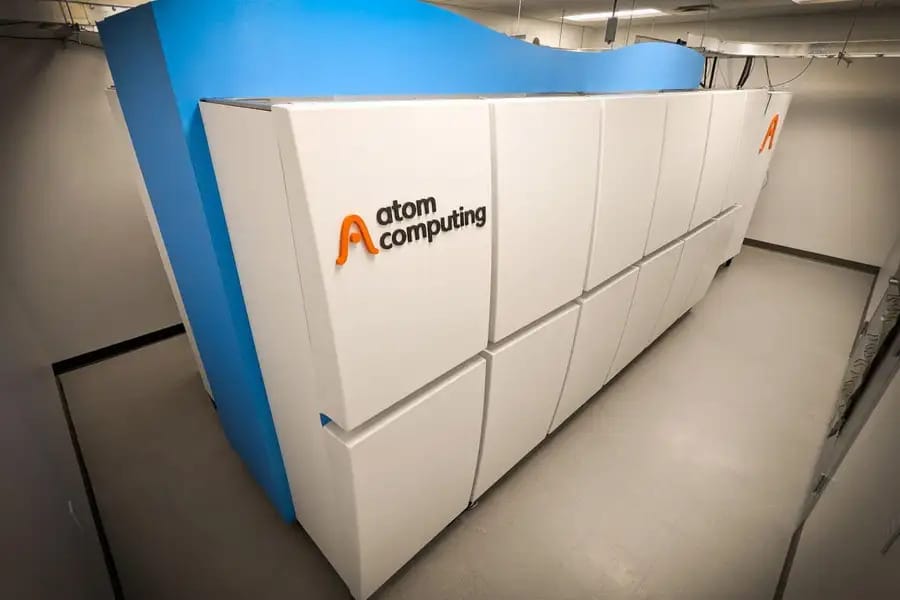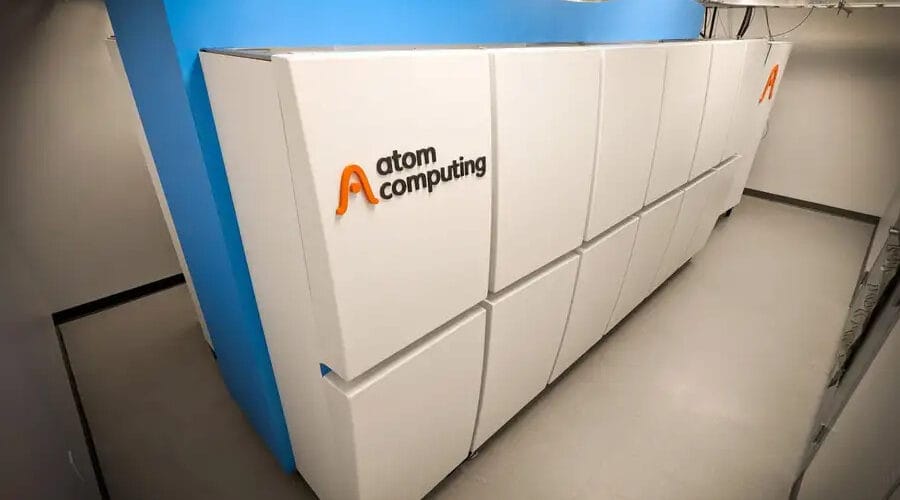Computer processing technology has just ascended to unparalleled heights after Atom Computing debuted a new quantum computer that has a processing power of 1,180 qubits.
To keep things simple as can be, a qubit is an unit used in computer measured in bits. Tech Target provides a basic but “sciencey” definition and how these computer work and are measured:
A qubit (short for quantum bit) is the basic unit of information in quantum computing and counterpart to the bit (binary digit) in classical computing. A qubit plays a similar role as a bit, in terms of storing information, but it behaves much differently because of the quantum properties on which it’s based.
In a quantum computer, a number of elemental particles such as electrons or photons can be used (in practice, success has also been achieved with ions), with either their charge or polarization acting as a representation of 0 and/or 1. Each of these particles is known as a qubit; the nature and behavior of these particles (as expressed in quantum theory) form the basis of quantum computing. Two of the most relevant aspects of quantum physics are the principles of superposition and entanglement.

When used as a qubit, a particle is placed in a controlled environment that protects it from outside influences. For example, it might be floated in a magnetic field or embedded specialized circuitry, which is then isolated from the outer environment. In many cases, the entire mechanism is encased in a refrigerated compartment to minimize subatomic disturbances, with temperatures often near absolute zero, or 0 Kelvin.
Researchers are experimenting with a variety of approaches to creating an environment in which the qubits can be reliably manipulated and measured without being affected by outside factors. For example, one approach is to suspend an electron in an electromagnetic field and control the electron’s spin state, while isolating the electron from external influences. When the electron’s spin is aligned with the field, it is in a spin-up state. When it is opposite to the electromagnetic field, it is in a spin-down state.
The electron’s spin can be changed from one state to another by directing a pulse of energy at the particle. The energy might come from a laser beam, microwaves or another source. Each time the pulse is delivered, the electron spin state changes. The switch in state provides a mechanism for assigning a 0 or 1 to each qubit, similar to a bit in classical computing. However, quantum computing makes it possible to do much more with a qubit.
Suppose that the energy pulse delivered to the electron is 1 unit of energy. What happens if the pulse is only one-half a unit of energy? According to quantum law, the particle enters a state of superposition, behaving as if it were in both the spin-up and spin-down states simultaneously. The electron exists in a fluid state of probability that is mathematically represented by fractions between 0 and 1. It remains in this state until it is observed and measured.
The superposition property enables a quantum computer to be in multiple states at once. The number of possible states grows exponentially as the number of qubits increases. The possible states are represented as 2n, where n is the number of qubits. The following table shows the number of possible states for five qubit amounts:
| Number of qubits | Number of possible states |
| 2 | 22 = 4 |
| 5 | 25 = 32 |
| 10 | 210 = 1,024 |
| 50 | 250 = 1.126 × 1015 (approximate) |
| 100 | 2100 = 1.268 x 1030 (approximate) |
A quantum computer can do much more with its qubits than a classical computer can with the same number of bits. For example, a 2-bit register in a classical computer can store only one of four binary configurations (00, 01, 10 or 11) at any given time. However, a 2-qubit register in a quantum computer can store all four numbers simultaneously, and as more qubits are added, the number of states continues to increase exponentially. To achieve this type of growth, however, quantum computers must also take advantage of another important quantum property: entanglement.
When particles are generated or interact in certain ways, they become entangled — that is, they retain a connection with each other even if separated by long distances. As part of this connection, their behavior is correlated across these distances as long as they remain entangled. Quantum computing uses this correlation to achieve the type of exponential growth promised by the superposition state.
When two entangled particles are measured, they are always in opposite spin states because of the correlation between them. When the spin state of one particle changes — whether from up to down or down to up — the spin state of the other particle also changes, but in the opposite direction. As a result, knowing the spin state of one entangled particle makes it possible to know the other’s spin state.
When an entangled particle is measured, it communicates with the correlated particle, which simultaneously assumes the opposite spin direction. Einstein called this phenomenon “spooky action at a distance,” and today’s physicists still do not know why it occurs. However, this behavior has been proved through numerous experiments. It is now generally accepted as a given and plays a key role in quantum computing.
Quantum entanglement enables qubits to interact with each other instantaneously. This interaction is not affected by distance or limited to the speed of light. Together with superposition, entanglement makes it possible to greatly enhance computing power and perform calculations in a fraction of the time compared with today’s most powerful classical computer.
Quantum computing is still in its infancy. Potential future applications include artificial intelligence and machine learning, financial modeling, cybersecurity, route and traffic optimization, manufacturing, drug and chemical research, and new materials to be incorporated into products such as batteries and semiconductors.
Furthermore, to put things in perspective, a single “byte” in classical computing represents 8 bits. A megabyte has 1,000,000 bytes; a gigabyte is 1,000 megabytes; a terabyte is 1,000 gigabytes or nearly 1 trillion bytes. Some of the more modern and expensive PCs purchased today will come equipped with 64mb of RAM and a 2 terabyte hard drive, for example.
Now, to demonstrate just how powerful these quantum computers are, in January Time Magazine did a whole piece on quantum computing and what it means for the future. The article references a quantum computer from IBM that was released just shy of a year ago, and at the time was the most powerful quantum computer. The processing power of that lone computer is almost unfathomable. Time wrote:
IBM unveiled its new 433-qubit Osprey chip—the world’s most powerful quantum processor, the speed of which, if represented in traditional bits, would far exceed the total number of atoms in the known universe.

So fast forward to now, courtesy of Atom Computing, their newest quantum computer has more than doubled IBM’s and released a computer that has 1,180 qubits, New Scientist reported.
Rob Hays, CEO of Atom Computing, said in a statement,
If we’re only going to scale by dozens of qubits, like most of the trapped ion and superconducting systems have been scaling up until now, it’s going to take a very long time to get to the fault tolerant era.
With the neutral atom approach and the speed of scaling that we have, we will be able to get there much more quickly.
Hays explained, adding that the team aims to multiply the amount of qubits in the machine by around 10 every couple of years or so.

In January when Time published their article, Dario Gil, IBM senior vice president and director of research, revealed that by 2025 IBM seeks surpass 4,000 qubits by ‘creating modular quantum circuits that link multiple processor chips in the same computer.’
Modularity is a big inflection point. We now have a way to engineer machines that will have tens of thousands of qubits.
Carsten Sapia, vice president of strategy, governance, and IT security at BMW Group, also added,
In the future, we will rely on everywhere in the world having access to quantum technology to run our business. So how can we set it up so no matter what happens on a geopolitical scale that we still have access to this technology?
She said
AUTHOR COMMENTARY
But thou, O Daniel, shut up the words, and seal the book, even to the time of the end: many shall run to and fro, and knowledge shall be increased.
Daniel 12:4
Indeed, the processing power of these machines are hard to even comprehend, and yet these scientists are claiming that they are exponentially faster ones than we already have in a relatively short amount of time. When you start to see things like this it becomes easier to understand how the elites who want the world and people to be run by AI, and live their lives in some metaverse, while being fully integrated into the grid. Gives a whole new perspective to the mark of the beast when it arrives.
SEE: Scientists Set New Record For Fastest Data Transmitting Chip At 1,000 Terabytes In A Second
[7] Who goeth a warfare any time at his own charges? who planteth a vineyard, and eateth not of the fruit thereof? or who feedeth a flock, and eateth not of the milk of the flock? [8] Say I these things as a man? or saith not the law the same also? [9] For it is written in the law of Moses, Thou shalt not muzzle the mouth of the ox that treadeth out the corn. Doth God take care for oxen? [10] Or saith he it altogether for our sakes? For our sakes, no doubt, this is written: that he that ploweth should plow in hope; and that he that thresheth in hope should be partaker of his hope. (1 Corinthians 9:7-10).
The WinePress needs your support! If God has laid it on your heart to want to contribute, please prayerfully consider donating to this ministry. If you cannot gift a monetary donation, then please donate your fervent prayers to keep this ministry going! Thank you and may God bless you.








“Gives a whole new perspective to the mark of the beast when it arrives.“ That’s the very first thing that popped in my head when I spotted your report as it’s under your Prophecy category.
The Antichrist system is going to have state-of-the-art computers and surveillance systems that will make everything thus far totally obsolete!
Hey Mom. I gotta math test, I gotta sit in the freezer to compute these.
This is nothing more than a abacus; to The Lord, it won’t out think God.
That’s all it is, a futuristic abacus. It will never outthink the Lord, He knows infinity more than that machine!